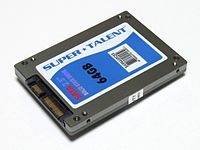
Photo from wikipedia
Rational design and exploration of safe, robust and inexpensive energy storage systems with high flexibility are greatly desired for integrated wearable electronic devices. Herein, a flexible all-solid-state battery possesses competitive… Click to show full abstract
Rational design and exploration of safe, robust and inexpensive energy storage systems with high flexibility are greatly desired for integrated wearable electronic devices. Herein, a flexible all-solid-state battery possesses competitive electrochemical performance and mechanical stability has been realized by easy manufacture processes using carbon nanotube enhanced phosphate electrodes of LiTi2(PO4)3 and Li3V2(PO4)3 and a highly conductive solid polymer electrolyte made of polyphosphazene/PVDF-HFP/LiBOB. The components were chosen based on their low toxicity, systematic manufacturability and (electro-)chemical matching in order to ensure ambient atmosphere battery assembly and to reach high flexibility, good safety, effective interfacial contacts, and high chemical and mechanical stability for the battery while operation. The high energy density of the electrodes was enabled by a novel design of the self-standing anode and cathode in a way that a large amount of active particles are embedded in the CNT bunches and on the surface of CNT fabric, without binder additive, additional carbon or large metallic current collector. The electrodes showed outstanding performance individually in half-cells with liquid and polymer electrolyte, respectively. The prepared flexible all-solid-state battery exhibited good rate capability that more than half of its theoretical capacity can be delivered even at 1C at 30 °C. Moreover, the capacity retentions are higher than 75% after 200 cycles at different current rates and the battery showed smaller capacity fading after cycling at 50 °C. Furthermore, the promising practical possibilities of the battery concept and fabrication method were demonstrated by a prototype laminated flexible cell.
Journal Title: ACS applied materials & interfaces
Year Published: 2020
Link to full text (if available)
Share on Social Media: Sign Up to like & get
recommendations!